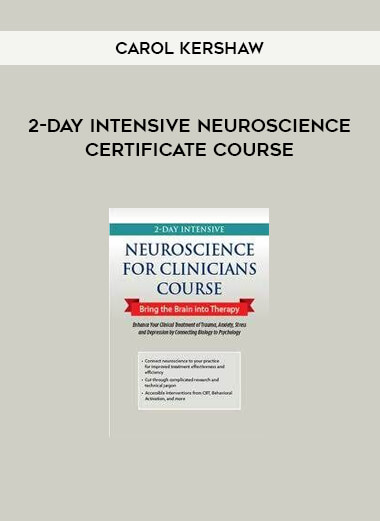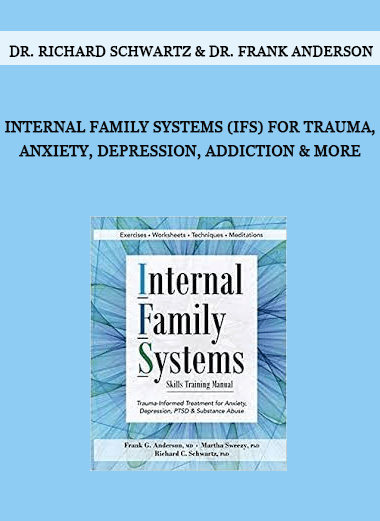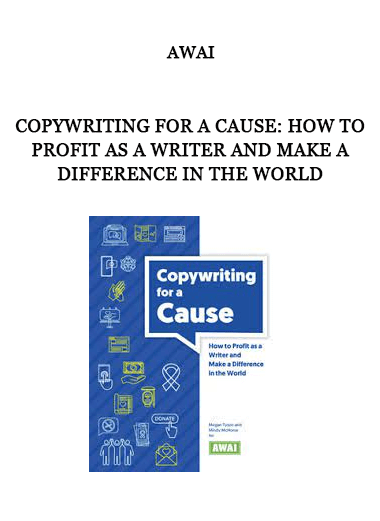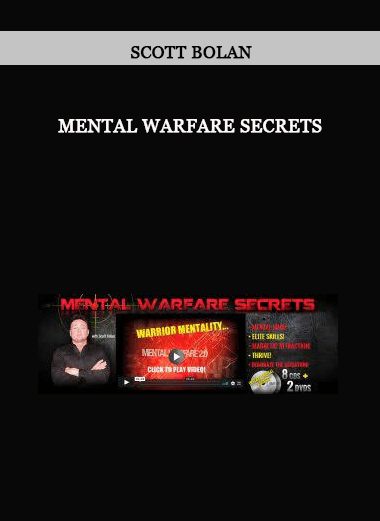Courses Infomation
2-Day Intensive Neuroscience Certificate Course by Carol Kershaw
 2-Day Intensive Neuroscience Certificate Course Bring the Brain into Therapy by Carol Kershaw, Bill Wade
2-Day Intensive Neuroscience Certificate Course Bring the Brain into Therapy by Carol Kershaw, Bill Wade
Faculty:Carol Kershaw | Bill Wade
Duration:12 Hours 13 Minutes | Format:Audio and Video
Archive : 2-Day Intensive Neuroscience Certificate Course by Carol Kershaw
Outline:
Utilize Neuroscience to Engage and Motivate Your Clients
simple explanations of the anatomy and operation of the brain
the neurobiology of certain illnesses
You have the capacity to change thanks to neuroplasticity.
Informing Customers About Brain Health
Nutrition and sleep quality
the fitness habit
Social support and its importance
negative effects of stress
How Your Clinical Practice Is Informed by Attachment and Relationship Neurobiology
the neural underpinnings of attachment
Effects of relationships on brain function
Mirror neurons, empathy, and social interaction
Oxytocin and the sense of identity
How your customers’ relationships are impacted by attachment style
The therapeutic relationship’s attachment and receptivity
Trauma: Integrating Neurobiology and Treatment
Trauma inflicted during childhood and the course of brain development
The fight, flight, or freeze reaction
The limbic system and implicit memory
Clinical approaches:
trigger recognition
Exposure
directed imagery
Grounding techniques
Stress and Anxiety: Control Your Emotions and Disrupt Worrying Thoughts
How the brain functions and is structured
stress routes, homeostasis, and stress reactions
The parasympathetic nervous system, mental wellness, and the resting state
Circuits of emotion and thought, as well as the sense of control, and why treatment should be concerned with this
Clinical approaches:
Labeling emotions and being mindful of them
Interventions that divert attention from worrying ruminations
Exercise can break up worrying routines.
Exercises for diaphragmatic breathing to control emotion
Susceptibility to harm brought on by stress
Techniques to Stop the Downward Spiral in Depression
The drawbacks of medication-based therapy
the neural pathways that control both happy and negative emotion
Depression risk and the negative bias of the brain
The brain’s amygdala in a depressed state
The spiraling downhill
rebuilding memories
Clinical approaches:
Behavioral activation: Live your life instead than just thinking about it
The treatment strategy includes problem-solving techniques from cognitive therapy.
The psychology of realistic objectives
Self-compassion can act as a symptom buffer for depression.
Checkup for Cognitive Health
Variable Attention Test (TOVA)
Evaluation of mood
Depression and dysfunctional biochemistry
Assessing memory
brain damage
Neurofeedback
Tools for Regulating Physiological Responses with Simple Biofeedback
Psychology and physiological regulation
play biofeedback
regulated breathing
Cardiovascular Variability
Training using EEG biofeedback
Cognitive costs in the age of information overload due to distraction
Task switching vs. multitasking: The multitasking myth
Mental states, synaptic connections, memory, and learning
Flexible goal-directed behavior and the prefrontal cortex
Educate clients on coping mechanisms that can:
Change negative behavioral habits
Reduce the amount of noise
Develop your ability to manage your time and organization.
the study of positive psychology in the brain
The basis of thankfulness in science
Remove obstacles to expressing appreciation
Easy exercises to practice thankfulness
The brain’s structure of forgiving
interventions based on strengths
States of flow
Combine awareness with action
Prefrontal cortex, inner critic, and flow
Limitations of positive psychology techniques in research
Research Limitations in Neuroscience and Potential Hazards
fMRI scanning
Things to consider while studying animals
straightforward justifications for complex procedures
Treatment risks and restrictions on research
Description:
To help your customers heal more effectively, you put a lot of effort into keeping up with the most recent research. Additionally, there is a wealth of studies in the subject of neurology that might help you practice more effectively and efficiently.
But how can you distinguish between discoveries that are pertinent to therapeutic practice and those that aren’t? How do you tell valuable findings apart from questionable, maybe harmful, pseudoscientific assertions? And how can you make the connections between intricate scientific knowledge and the practical therapies you require to assist clients with the day-to-day mental health problems they encounter?
The most recent research in the disciplines of neurology and neurobiology will be linked in this video to therapeutic approaches you may use in routine clinical settings.
You will learn how to use practical and flexible strategies based in cognitive therapy, attachment, mindfulness, behavioral activation, and positive psychology to treat anxiety, stress, trauma, and depression. You will also understand why neuroscience important to therapy.
Don’t allow perplexing scientific terminology and research prevent you from modernizing your practice or from incorporating a neuroscience-informed strategy into your therapeutic work.
Build the self-assurance you need to include the brain in treatment by overcoming the difficulties of deciphering challenging scientific data!
Salepage : 2-Day Intensive Neuroscience Certificate Course by Carol Kershaw































Reviews
There are no reviews yet.